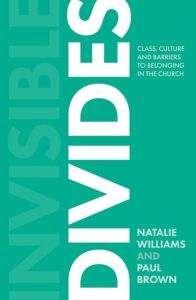
Invisible Divides: Class, Culture, and Barriers to Belonging in the Church is co-authored by Natalie Williams and Paul Brown.
In today’s church landscape, discussions about inclusion often focus on race, gender, and sexuality and rightly so. However, Invisible Divides brings to light another critical aspect: social class. Authors Natalie Williams and Paul Brown delve into how class distinctions create unseen barriers within our congregations, affecting who feels truly at home in our pews.
Including the working class and lower income is something I am passionate about. Unless the church is reaching the most disadvantaged person it isn’t doing it’s job in my opinion.
Summary Of Invisible Divides
The book is divided into three main sections:
Is Class an Issue?
Here, the authors explore the often-overlooked reality that many Western churches are predominantly middle-class environments. They question why, despite outreach efforts, individuals from working-class backgrounds frequently struggle to find a sense of belonging within church communities.
Different Ways We Think and Act
This section examines the subtle cultural differences that can lead to misunderstandings and feelings of exclusion. Topics include varying communication styles, attitudes toward authority, and definitions of hospitality. The authors highlight how these differences, though often invisible, significantly impact one’s church experience.
Church Life
The final section offers practical advice on how churches can become more inclusive. Williams and Brown provide insights into making church activities, leadership structures, and community life more accessible and welcoming to people from all social classes.
What Stood Out
What I loved most about this book was the use of personal narratives. Both authors share their journeys from working-class backgrounds to church leadership, offering authentic insights into the challenges faced along the way.
Their experiences really make you think about your church and how you approach everything you are do.
Additionally, the book doesn’t shy away from challenging the status quo. It calls on churches to reflect deeply on their cultures and practices, encouraging a move beyond mere acknowledgment of diversity toward genuine inclusion. From my own experience this is not easy and I’ve seen first hand how people ‘not like us’ can be made to feel.
This book encourages a re-evaluating of the unspoken norms that may alienate those from different social backgrounds.
Personal Reflections
I am the audience for this book, because the topic is something always on my mind. For me it was a breath of fresh air. I think for others it may be more challenging.
The main point I am taking away from this book is are we creating a church that gives to the poor or sits with the poor? They are different. We need to inviting people to our table not just making sure there is food on theirs ( although that is also important).
It also made me think a lot about those that think we shouldn’t ‘dumb down Christ and the language we use’. And while on one hand they are right we must, I feel, speak in a language people can understand and relate to and I think we are not great at that.
Recommendation
Invisible Divides is essential reading for church leaders, ministry teams, and congregation members alike. It challenges readers to confront uncomfortable truths about class and encourages proactive steps toward creating truly inclusive communities.
If you’re interested in understanding and bridging the class divides within the church, this book offers both the insights and practical guidance needed to begin that journey.
I loved this book and can’t recommend it enough if this is a subject you really want to learn about.


